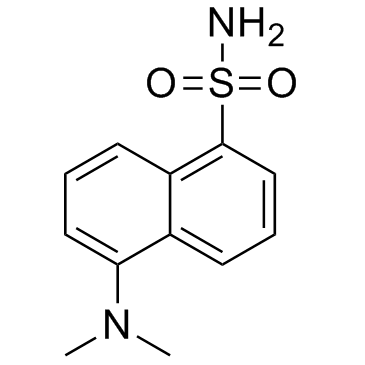Dansyl amide

Dansyl amide structure
|
Common Name | Dansyl amide | ||
|---|---|---|---|---|
| CAS Number | 1431-39-6 | Molecular Weight | 250.317 | |
| Density | 1.3±0.1 g/cm3 | Boiling Point | 435.4±37.0 °C at 760 mmHg | |
| Molecular Formula | C12H14N2O2S | Melting Point | 218-221ºC | |
| MSDS | Chinese USA | Flash Point | 217.1±26.5 °C | |
|
Macromolecular Systems with MSA-Capped CdTe and CdTe/ZnS Core/Shell Quantum Dots as Superselective and Ultrasensitive Optical Sensors for Picric Acid Explosive.
ACS Appl. Mater. Interfaces 7 , 24778-90, (2015) This work reports the development of highly fluorescent materials for the selective and efficient detection of picric acid explosive in the nanomolar range by fluorescence quenching phenomenon. Poly(vinyl alcohol) grafted polyaniline (PPA) and its nanocomposi... |
|
|
Alteration of human serum albumin tertiary structure induced by glycation. Spectroscopic study.
Spectrochim. Acta. A. Mol. Biomol. Spectrosc. 153 , 560-5, (2015) The modification of human serum albumin (HSA) structure by non-enzymatic glycation is one of the underlying factors that contribute to the development of complications of diabetes and neurodegenerative diseases. The aim of the present work was to estimate how... |
|
|
Optimizing Multiple Analyte Injections in Surface Plasmon Resonance Biosensors with Analytes having Different Refractive Index Increments.
Sci. Rep. 5 , 15855, (2015) Surface plasmon resonance-based biosensors have been successfully applied to the study of the interactions between macromolecules and small molecular weight compounds. In an effort to increase the throughput of these SPR-based experiments, we have already pro... |
|
|
Nutritional and health-promoting properties of bean paste fortified with onion skin in the light of phenolic-food matrix interactions.
Food Funct. 6 , 3560-6, (2015) The study examined the effect of fortification of bean paste with onion skin phenolics. The antioxidant potential and in vitro digestibility of nutrients in the light of phenolic-food matrix interactions were studied. Bean paste was supplemented with onion sk... |
|
|
How many antimicrobial peptide molecules kill a bacterium? The case of PMAP-23.
ACS Chem. Biol. 9(9) , 2003-7, (2014) Antimicrobial peptides (AMPs) kill bacteria mainly through the perturbation of their membranes and are promising compounds to fight drug resistance. Models of the mechanism of AMPs-induced membrane perturbation were developed based on experiments in liposomes... |
|
|
Molecular basis for the origin of differential spectral and binding profiles of dansylamide with human carbonic anhydrase I and II.
Biochemistry 44(10) , 3673-82, (2005) Sulfonamide derivatives serve as potent inhibitors of carbonic anhydrases (CAs), and a few such inhibitors have been currently used as drugs for the treatment of different pathogenic conditions in humans. In pursuit of designing the isozyme-specific inhibitor... |
|
|
Fluorescent reporters of the histone acetyltransferase
Anal. Biochem. 380(1) , 106-10, (2008) Histone acetyltransferases (HATs) are important chromatin modifying enzymes that catalyze acetylation of specific lysine residues in histone and nonhistone substrates. They participate in multiple cellular processes such as transcriptional regulation and sign... |
|
|
A fluorescence study of human serum albumin binding sites modification by hypochlorite.
J. Photochem. Photobiol. B, Biol. 94(2) , 77-81, (2009) A study has been made on the properties of human serum albumin (HSA) binding sites and how they are modified by pre-oxidation of the protein with hypochlorite. The oxidation extent was assessed from changes in the protein intrinsic fluorescence and production... |
|
|
Stabilization of anionic and neutral forms of a fluorophoric ligand at the active site of human carbonic anhydrase I.
Biochim. Biophys. Acta 1804(10) , 1965-1973, (2010) We synthesized a fluorogenic dansylamide derivative (JB2-48), which fills the entire (15 A deep) active site pocket of human carbonic anhydrase I, and investigated the contributions of sulfonamide and hydrophobic regions of the ligand structure on the spectra... |
|
|
Thiol dependent isomerization of bovine albumin
Int. J. Biol. Macromol. 44(1) , 43-50, (2009) Albumin isomerizes to the aged form in the presence of cysteine at pH 8.9 and low ionic strength. Albumins with a high fatty acid and Cu(II) content do not produce isomers, and recover this capacity after an acid expansion. Isomers have the free thiol group f... |